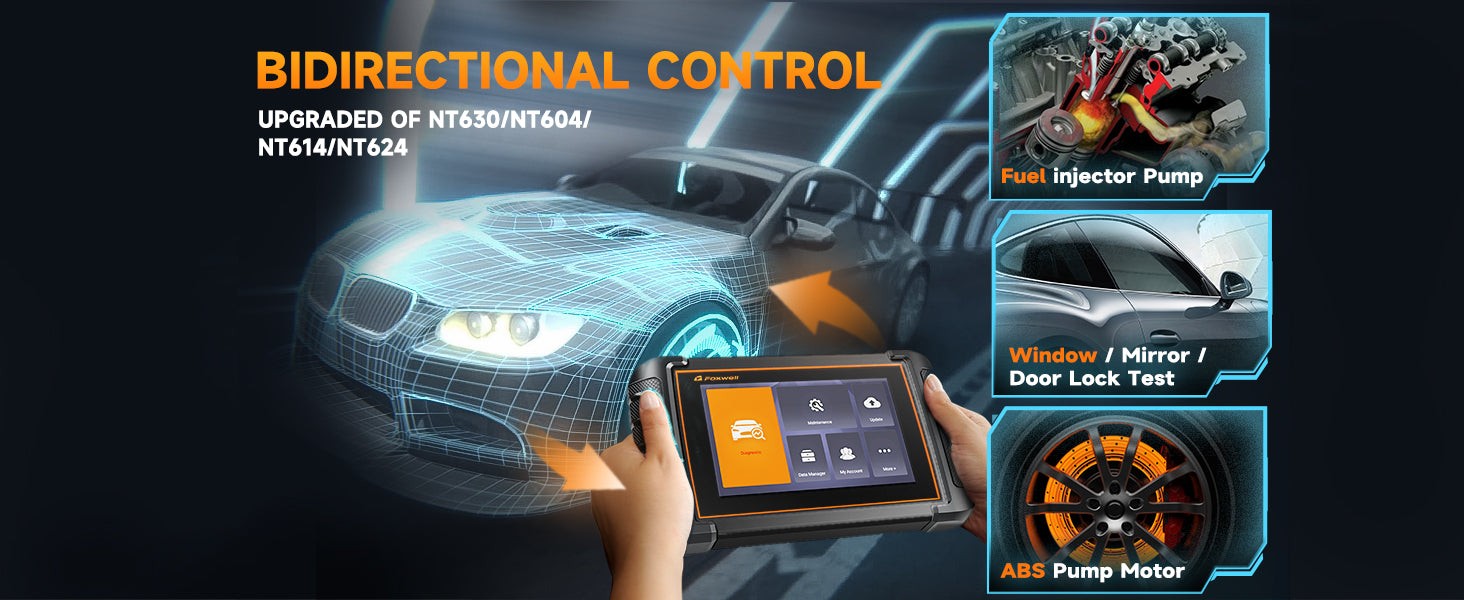Automotive maintenance is increasingly reliant on technology, and two systems stand out for their contribution to safety and performance: OBD2 (On-Board Diagnostics II) scanners and Tire Pressure Monitoring Systems (TPMS). While both are crucial for modern vehicles, they serve different purposes, leading to a common question among car owners and technicians: can you use an OBD2 scanner to clear TPMS issues?
Alt text: Foxwell bi-directional control scanner displaying diagnostic information on its color screen, used for advanced vehicle diagnostics.
This article will delve into the capabilities of OBD2 scanners regarding TPMS, explain why specialized TPMS tools are often necessary, and guide you on choosing the right equipment for tire pressure system maintenance.
Understanding Tire Pressure Monitoring Systems (TPMS) and Their Importance
A Tire Pressure Monitoring System (TPMS) is an electronic system in your vehicle that constantly monitors the air pressure in your tires. This system provides real-time tire pressure information to the driver, typically through a dashboard warning light, a pictogram display, or a gauge. TPMS is integral to vehicle safety because maintaining proper tire pressure is not just about tire longevity or fuel efficiency—it’s a critical safety factor.
Why Tire Pressure Monitoring Systems are Vital for Vehicle Safety
Correct tire inflation is paramount for safe driving. Under-inflated tires can severely compromise vehicle safety in several ways:
- Reduced Steering and Handling: Low tire pressure diminishes a vehicle’s responsiveness, making steering sluggish, particularly at high speeds or in emergency maneuvers.
- Increased Risk of Tire Failure: Underinflation leads to excessive flexing of the tire sidewalls, generating increased heat. This heat buildup can cause tire blowouts, which are dangerous and can lead to accidents.
- Longer Stopping Distances: Vehicles with improperly inflated tires require a greater distance to come to a complete stop. This is especially hazardous in sudden stop situations or heavy traffic.
By continuously monitoring tire pressure and alerting drivers to deviations, TPMS acts as a crucial safety net. It allows drivers to address tire pressure issues before they escalate into dangerous situations, thereby playing a significant role in accident prevention and enhancing overall road safety. Regular maintenance, including understanding tools like OBD2 scanners and TPMS-specific devices, is key to ensuring your vehicle’s safety systems operate effectively.
Standard OBD2 Scanner Capabilities and TPMS: What to Expect
OBD2 scanners are primarily designed to diagnose engine and emission-related problems. They excel at reading and clearing diagnostic trouble codes (DTCs) linked to the engine control unit (ECU) and related systems. While OBD2 scanners offer valuable insights into vehicle health, their capabilities concerning TPMS are often limited.
How OBD2 Scanners Interact with Vehicle Systems
Standard OBD2 scanners can:
- Diagnose Engine Issues: They can quickly identify problems within the engine, such as misfires, emission control faults, and sensor malfunctions.
- Read and Reset Generic DTCs: OBD2 scanners are capable of reading and clearing generic diagnostic trouble codes that are standardized across most vehicles. These codes are primarily related to engine and emission systems.
However, TPMS issues often generate manufacturer-specific codes that go beyond the scope of basic OBD2 scanners. Although some advanced OBD2 scanners might access body control and chassis control functions, their ability to interact with TPMS for resets and reprogramming is generally restricted.
Limitations of Standard OBD2 Scanners for TPMS Reset
When it comes to TPMS, standard OBD2 scanners typically have limited functionality. They may be able to:
- Read TPMS-related Codes: Some OBD2 scanners can read generic TPMS fault codes, alerting you to a problem within the system.
- Display Basic TPMS Data: Certain scanners might display basic TPMS information, such as whether the system is reporting a fault.
However, standard OBD2 scanners generally cannot:
- Reset the TPMS Light: Clearing the TPMS warning light often requires more than just reading and clearing codes, especially if the underlying issue is resolved (like reinflating a tire).
- Reprogram TPMS Sensors: When TPMS sensors are replaced (due to damage or battery failure) or tires are rotated, the system may need to relearn the new sensor IDs. Standard OBD2 scanners lack the functionality to perform these reprogramming or relearn procedures.
- Diagnose Specific Sensor Issues: While they might indicate a general TPMS fault, pinpointing problems to individual sensors (like a faulty sensor or low sensor battery) is usually beyond the capability of a basic OBD2 scanner.
This limitation stems from the fact that TPMS operates on manufacturer-specific protocols and often requires bidirectional communication to perform resets and reprogramming—features not commonly found in generic OBD2 scanners.
Why Specialized TPMS Scanners Are Necessary for Comprehensive Maintenance
For in-depth TPMS maintenance, including resetting, reprogramming, and diagnosing sensor-specific issues, specialized TPMS scanners are often essential. These tools are designed to overcome the limitations of generic OBD2 scanners and offer comprehensive interaction with the TPMS module.
Alt text: Close-up of a Foxwell car scanner powered by a car battery, highlighting its portability and use in vehicle diagnostics and maintenance.
Advantages of TPMS-Specific Scanners
Specialized TPMS scanners provide several key advantages:
- Manufacturer-Specific Protocols: TPMS scanners are equipped to communicate using the unique protocols used by different vehicle manufacturers. This allows them to interact directly and effectively with the TPMS module, regardless of the vehicle brand.
- Advanced Functionality for Reset and Programming: Resetting the TPMS light after correcting tire pressure or rotating tires, and programming new sensor IDs after replacement, are standard functions in TPMS scanners. They guide users through relearn procedures and sensor programming steps that are crucial for proper TPMS operation.
- Comprehensive Diagnostics: TPMS-specific tools can perform in-depth diagnostics, such as checking individual sensor health (battery status, pressure readings, temperature), identifying faulty sensors, and performing system tests.
- Integrated Features for Efficient Workflow: Many TPMS scanners include features that streamline TPMS maintenance, such as:
- Sensor Activation/Triggering: To wake up sensors for reading and programming.
- Sensor Programming: To clone sensor IDs or program new universal sensors.
- Health Checks: To quickly assess the status of all TPMS sensors.
- Real-time Data Display: To monitor live sensor data, which is invaluable for accurate diagnosis.
These advanced capabilities make TPMS scanners indispensable for automotive technicians and serious DIYers who need to perform thorough TPMS maintenance and ensure the system functions correctly after tire service or sensor replacements.
Key Features to Look For in a TPMS-Specific Scanner
When selecting a TPMS scanner, several features are crucial to consider to ensure it meets your needs:
- Broad Sensor Compatibility: The scanner should support a wide range of TPMS sensors across various vehicle makes and models. Compatibility lists are usually provided by manufacturers; check if your vehicles are covered.
- Robust Sensor Programming Capabilities: Ensure the scanner can program new sensors, whether you’re using OEM replacement sensors or aftermarket universal programmable sensors. Features like auto-create ID, manual ID input, and clone ID are beneficial.
- User-Friendly Reset and Relearn Procedures: The scanner should offer clear, step-by-step guidance for TPMS reset and relearn procedures. These procedures can vary between vehicle makes, so clear instructions are vital.
- Live Data Monitoring and Diagnostics: Look for a scanner that displays real-time data from each sensor, including pressure, temperature, and battery voltage. This live data is crucial for accurate diagnosis and verifying sensor functionality.
- Regular Software Updates: TPMS technology and vehicle systems evolve. Choose a scanner from a manufacturer that provides regular software updates to ensure compatibility with the latest vehicle models and TPMS technologies.
Foxwell TPMS Scanner Solutions: NT310 and NT530
Foxwell offers a range of diagnostic tools known for their comprehensive capabilities and reliability, particularly in TPMS maintenance. Two models that stand out for TPMS work are the Foxwell NT310 and NT530.
Foxwell NT310 TPMS Universal Tool: Dedicated TPMS Functionality
The Foxwell NT310 is specifically designed as a TPMS universal tool. It excels in:
- TPMS Diagnostics: It can trigger sensors, read sensor data, and perform TPMS system diagnostics.
- Sensor Programming and Relearn: It allows programming of universal sensors and performs TPMS relearn procedures efficiently.
- User-Friendly Operation: The NT310 is designed with ease of use in mind, featuring a straightforward interface that makes TPMS tasks accessible for both professionals and DIY users.
The NT310 is an excellent choice for those who primarily need a dedicated tool for TPMS work and appreciate a focused, easy-to-use device.
Foxwell NT530 Multi-System Scanner: Versatility with TPMS Capabilities
The Foxwell NT530 is a multi-system diagnostic scanner that offers broad vehicle system coverage, including comprehensive TPMS functionality. It provides:
- All-System Diagnostics: Beyond TPMS, it diagnoses engine, transmission, ABS, airbags, and other vehicle systems.
- Advanced TPMS Functions: It includes TPMS reset, relearn, and basic sensor data reading capabilities.
- Vehicle-Specific Software: The NT530 utilizes vehicle-specific software, making it function close to an OEM-level diagnostic tool for various brands. This ensures accurate TPMS resets and diagnostics across different makes.
- Bidirectional Tests: The NT530 supports bidirectional tests, allowing you to send commands to vehicle components to perform specific actions—useful for troubleshooting and verifying repairs, including within the TPMS system.
The NT530 is ideal for users who need a versatile scanner that can handle TPMS tasks along with comprehensive diagnostics for other vehicle systems. It’s a valuable tool for professional mechanics and advanced DIYers who work on a variety of vehicles.
Shared Advantages of Foxwell NT310 and NT530 for TPMS
Both the Foxwell NT310 and NT530 share key advantages for TPMS work:
- Direct TPMS Support: Both scanners offer direct access to the vehicle’s TPMS module, enabling effective monitoring and resetting of the system.
- Extensive Vehicle Coverage: They support a wide range of vehicle makes and models equipped with TPMS, ensuring broad applicability.
- Regular Software Updates: Foxwell provides regular software updates for both models, keeping them compatible with new vehicles and the latest TPMS technologies.
Conclusion: Choosing the Right Tool for TPMS Maintenance
In summary, while some advanced OBD2 scanners may read basic TPMS codes, they generally lack the specialized functions needed to reset TPMS lights, reprogram sensors, or perform in-depth TPMS diagnostics. For comprehensive TPMS maintenance, a specialized TPMS scanner is often necessary.
Tools like the Foxwell NT310 and NT530 offer the dedicated TPMS functionalities, vehicle coverage, and ease of use required for effective TPMS management. The NT310 is a focused, user-friendly TPMS tool, while the NT530 provides versatility with comprehensive system diagnostics including robust TPMS capabilities.
Choosing the right scanner depends on your needs: for dedicated TPMS tasks, the NT310 is excellent; for broader diagnostic needs including TPMS, the NT530 is a powerful option. Investing in the appropriate tool ensures you can maintain your vehicle’s TPMS effectively, contributing to safety and optimal vehicle performance.
FAQs
Can the Foxwell NT530 perform TPMS Resets?
Yes, the Foxwell NT530 is capable of performing TPMS resets as part of its comprehensive diagnostic functions for vehicle systems. It is well-suited for thorough vehicle system diagnostics, including TPMS.
Is the Foxwell NT310 Suitable for Professional Use?
Yes, the Foxwell NT310 is indeed suitable for professional use, particularly for automotive repair shops and service departments. Its primary functionality is centered around TPMS diagnostics, including sensor triggering, programming, and relearn procedures, making it a valuable tool for TPMS-specific tasks.
Do Foxwell Scanners Come Equipped with Updates for New Vehicle Models?
Yes, Foxwell regularly releases software updates for their NT310 and NT530 scanners. These updates ensure compatibility with new vehicle models and advancements in automotive technologies, keeping your scanner current and effective.

